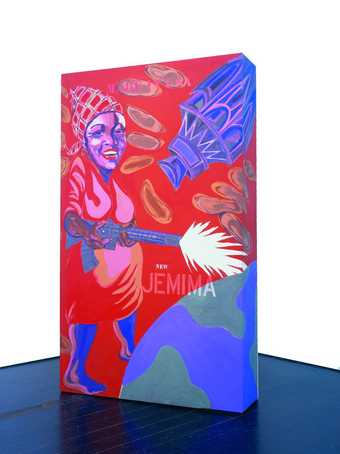Was pop art a term used by yourself or colleagues or was there a different terminology that referred to a new figurative art movement in the 1960s and early 1970s?
I always thought of pop art as undermining abstraction. Therefore, I had not thought of my painting as pop, but rather as a defined image of an African-American woman who had been marked and subjugated. I don’t remember, in general, that the term ‘pop art’ had much currency among African-American artists at that time.
Did you ever consider yourself (now or in the past) a pop artist?
No, I never considered myself to be a pop artist mainly because I never had a full understanding of its logic. My artist friends at the time talked mostly about art as needing to be politically and socially engaged. Some of them wanted no categories of any sort.
Did your work engage with current events in the 1960s and early 1970s?
I was born in Conehatta, a very rural place, not far from Philadelphia, Mississippi, where three young civil rights workers were murdered in 1964. I have been aware of inequalities in civil rights for most of my adult life. So, absolutely, in the 1960s I was involved in the civil rights struggle so that black people could receive equal opportunities. I demonstrated. I showed paintings in civil rights exhibitions. I worked at the Black Arts Repertory Theater in Harlem. Before that I worked in San Francisco and Oakland as part of the Beat Movement, with Bob Kaufman, Eric ‘Big Daddy’ Nord and Allen Ginsberg.

Joe Overstreet
The New Jemima 1964
Menil Collection, Houston, USA
© Joe Overstreet
How did you choose the subject matter for your work included in The World Goes Pop?
I read in a magazine that Nancy Green, who was born in slavery in Kentucky, cooked around a million pancakes at the 1893 Chicago World’s Exposition in order to save a pancake flour company. She made me think of my grandmother, my mother, and I thought she must have been very tired. And I knew Jemima was tired of that role. The painting – The New Jemima – has a double meaning. So my painting reveals the New Jemima who chose a machine gun as her stove, for her kitchen equipment.
Where did you get your imagery from (what, if any, sources did you use)?
I observed the trademark on an Aunt Jemima pancake flour box, and then generalised it, trying to create an idealised black woman, who was smiling and comforting, and representing a nostalgic, personified image of Southern hospitality.
Were you aware of pop art in other parts of the world?
No, I had not thought of pop art as an international movement, nor as a vehicle. At that time, I generally thought mostly about abstraction or only occasionally, realism. My friends that I talked with – Amiri Baraka, De Kooning, Norman Lewis, Ishmael Reed, Salvatore Scarpitta, Hale Woodruff – spoke to me with an educational consciousness.
Was commercial art an influence on your work or the way in which it was made?
I have never thought of my work as commercial, but in this instance, I used a commercial image of a pancake box to make a point about social and cultural revolution and black people. It is the only painting like this that I ever made. But, when I think about it, around that time, my stretch paintings developed from a box, opened up and flattened, and then I found a tent.
Was there a feeling at the time that you were doing something important and new, making a change…?
Yeah, but I always feel that, even today. Still, at that time, I was determined to make a change on many levels. It was a complex, intense period. I felt hopeful.
Was there an audience for the work at the time – and if so what was their reaction to it?
In 1964 I made a large painting (2604 x 1543 mm) of Jemima: The New Jemima. Larry Rivers saw it around 1970, and he said that if I made it larger, he would include it in the Some American History exhibition at Rice University. So I made a kind of wooden armature so that the painting would resemble something like a pancake box. I enlarged it especially for this art project, which was part of the effort in 1971 to desegregate Rice University. Rice had a codicil that blacks could never attend that institution.
Looking back at these works, what you do think about them now?
In my painting, I think it is also easy for people to understand the rage, political consciousness, even the irony of the subject. ‘Mammy’ was one of the favourite stereotypes created by whites to control African Americans. Black folks were disgusted with these old, tired and exasperating ideas. In the new world of intergalactic space travel, New Jemima decided to take a stand. So my painting reveals the New Jemima who chose a machine gun as her stove, for her kitchen equipment. She is shooting rapid-fire pancakes.
September 2015
